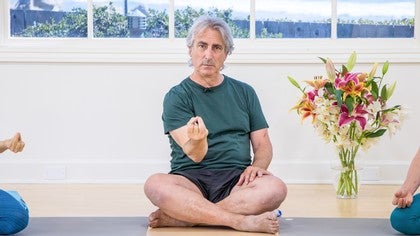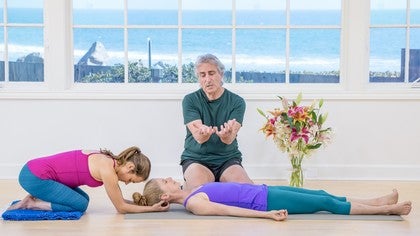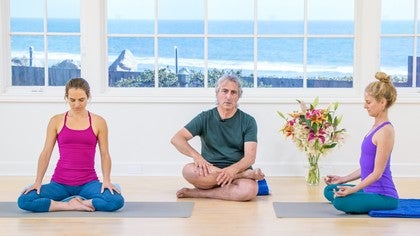Description
About This Video
Transcript
Read Full Transcript
Hi, we're here again with Betsy and Lana, and the practice now is called nadi shodhana. A nadi is usually an artery or a vein. Physical arteries and veins are known as nadis, but also the subtle channels in the subtle body that transport the piranha through the body are also called nadis. Shodhana means to purify, and so nadi shodhana is a practice that purifies the energy channels in the physical and subtle bodies. It's a very old practice, but it's not a pranayama.
It's not a formal pranayama. It's what's called a kriya, which means it's an act. It's what kriya means, and it's an act of purification, preparation for pranayama. The claim is that it balances the hemispheres of the brain, and that remains to be seen, but it's also a nice preparation for breathing nonetheless. It involves, however, use of the fingers, and traditionally it's the right hand that's used, whether or not you're right-handed or left-handed, but if you are left-handed, it's perfectly all right to use your left hand. This is an old restriction about left-handers that really doesn't need to apply any longer. The mudra that you use, the hand gesture that you use to manipulate the nostrils is a little bit difficult to create it right at first if you're not used to doing that.
So this is what we'll do. Alana and I will both demonstrate. She'll use her left hand because she's left-handed, and I'll use my right hand. In order to make the mudra, which by the way is called the dear mudra, sometimes called the Vishnu mudra, the first thing to do is to make a fist, a very deep, compact fist. Yes, and you burrow the tips of the index and middle fingers into the mound of the thumb, and then let go of the ring finger and the little finger like this. These three fingers are now extended away from the hand or the palm.
Here comes the hard part. You've got to be able to cross the ring finger on top of the little finger and make a single finger pad out of the two. It's much preferable when you do this exercise to use the tips of the fingers rather than the pads of the fingers. So if you have long fingernails, obviously you won't be able to use the tips of the fingers. You'll have to use the pads.
But my research indicates that the tips of the fingers are the most sensitive parts of the hand, and therefore it's very useful to have the tips of the fingers to use on the nostrils. Very good. Now, the next thing is to bring the hand up to the nose. There is a tendency for you to turn your head toward your hand, so I would turn my hand to the right, and Ilana, if she was doing that, would turn her head to the left. But it's very important to keep the head in a neutral position.
In other words, keep the chin over the sternal notch. Bring the hand up to the nose, and I'm using the tips of my fingers as you can see. Nadi Shodhana, you begin by closing the right nostril, and I use my thumb to do that, like this. The left nostril stays open. And I'll take an inhalation through the left nostril.
I'm just going to describe this at first. After I'm finished with the inhalation, I'll close the left nostril using my ring finger and pinky, and open the right, and then I'll exhale through the right. When the exhale is finished, I'll leave the right nostril open, inhale through the right, close it at the end of the inhale, open the left, exhale through the left, and that is one round. Let me demonstrate what I just did from the side, both sides, so it's a little bit easier to see, hopefully. First, I'll turn my right side to you.
Again, let me describe this. Using the right hand, bring it up to the nose. Again, I'm making very certain that I'm not turning my head toward the hand to bring in the hand to the nose. The first thing I'll do is close the right nostril, which means I'll use the thumb to do that. I'll inhale left, then I'll close the left nostril, the ring finger and pinky doing that, open the right, exhale, inhale through the right, close it, exhale left.
That's one round. Now I'll go around to the other side, my left side toward you. Here we go again. Now, let me just make a point here that some schools of yoga reverse the order of breathing, so don't be confused if you go to a class that breathes in through the left nostril first. It's a different way of doing it, it's just as legitimate, just a different way.
But the way I learned was to breathe in through the left nostril first. Let's start. Now, it's also very important to keep the shoulders down away from the ears, and don't do strange things with your wrists or elbows. Keep the elbow down by the side of the torso and the wrist in a relatively neutral position. Again, I'm closing the right nostril with my thumb and inhaling through the left.
Close the left, open the right, exhale, and then leave it open, inhale right, and then close it, exhale left. Now, when you put your fingertips on your nose, you don't want to put them right on the wings of the nose. If you feel around just behind the bumps on the sides of your nose, you'll find a couple of little dents just behind the wings of the nose. The wings of the nose are called the alae. The alae is a singular of that word, it means wing.
And the tips of the fingers will fit very neatly into those little hollows. And you have to be sure that when you close the nostrils, that you don't distort the septum. You just put enough pressure on the nostril to close it, but without pushing the nostril over to the side. So let's try a few. Betsy is going to do something a little different.
She's not going to use her hand to do this. She's going to imagine that she's closing her nostrils with her hand, and she'll just direct the inhalations imaginatively through the different nostrils. So, first thing to do is to make the mudra, and then bring the hand up to the nostril. And again, bring the hand to the nose, don't bring the nose to the hand. Elbow down by the side of the torso, wrist in a neutral position, and we'll start by closing the right nostril.
Now I'll use my thumb, and Ilana will be using her ring finger and little finger. And we'll inhale left. Close the left, open the right, exhale. Leave the right open, inhale. Close it, open the left, exhale.
Let's do that one more time. Inhale left. Close it, open the right, exhale. Leave it open, inhale. Close it, exhale left.
And then bring your hand down onto your thigh or knee and let go of the mudra. You can stretch your fingers out. Now, there is no particular number that you should do of this. I would say to start out with about five to eight repetitions of this, and you can go up to maybe 10 or 12 comfortably, and then come back to everyday breathing at the end of the practice. Again, this is called Nadi Shodhana, the purification of the energy channels in the subtle body.
It's not a form of pranayama quite yet. It's what's known as one of the shakri, as one of the six actions that purify the body in preparation for yoga in general and for pranayama in particular. Thank you very much.
Pranayama & Meditation: Meet Your Breath
Comments

You need to be a subscriber to post a comment.
Please Log In or Create an Account to start your free trial.











